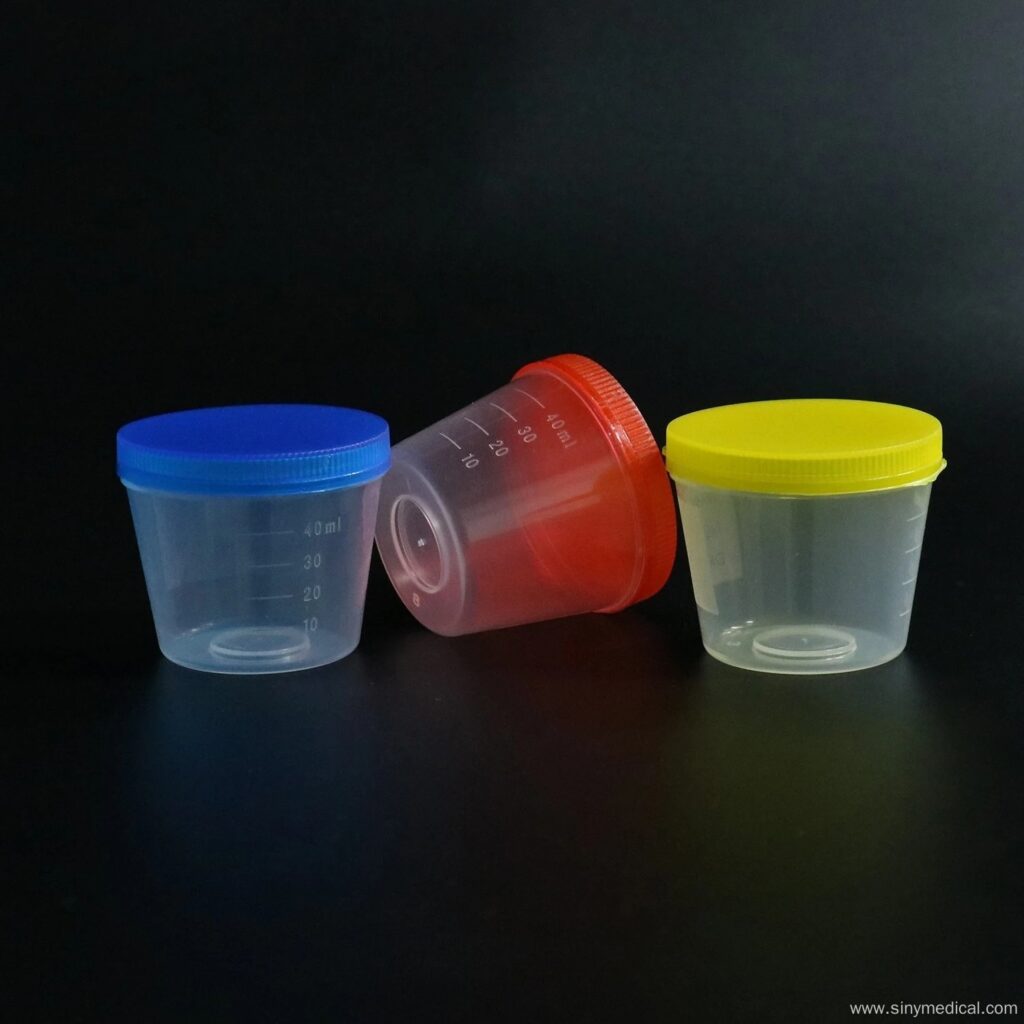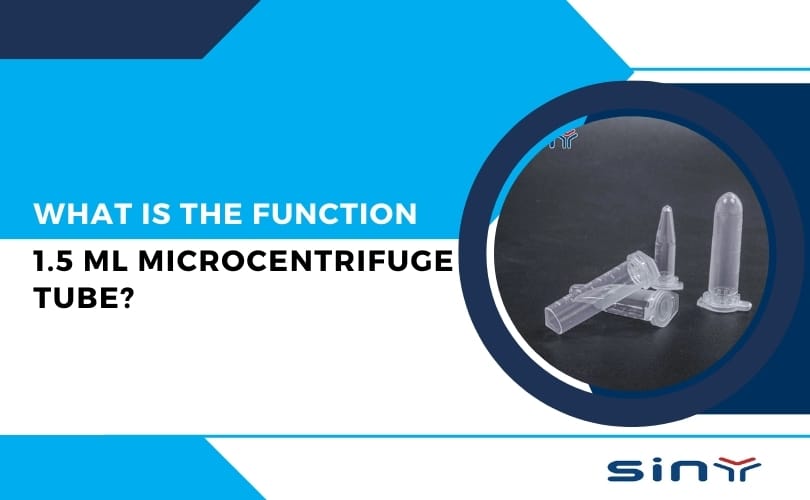A specimen cup is a container used to collect, store, and transport biological samples or other material samples.
A specimen cup is a specialized container for collecting, storing, and transporting biological specimens for laboratory testing and analysis. Typically made from shatterproof polypropylene, these cups feature a cap that helps prevent leakage and block odors.
Table of Contents
What is a specimen cup?
A sterile container designed to collect and store biological samples, such as urine, stool, sputum, or other bodily fluids and tissues, the specimen cup plays a crucial role in laboratory analysis. Made from durable plastic, these cups securely hold the sample, preventing contamination or leakage. The cups usually come with a tight-sealing lid to maintain the integrity of the sample from the point of collection until it reaches the laboratory for testing.

Application
Medical field
In clinical examinations, healthcare professionals often use specimen cups to collect samples like urine, blood, and sputum for various laboratory tests, including routine urine analysis, blood tests, and biochemical assessments.
Specimen cups may also be used during surgery to collect tissue samples for pathological examination to determine the nature and extent of the disease.
Scientists use specimen cups to collect various biological samples, such as plant specimens, animal specimens, microbial samples, etc., to study species classification, ecological environment, genetic variation, and other issues.
In molecular biology and biotechnology research, specimen cups can be used to collect and preserve biological macromolecule samples such as DNA, RNA, and protein.
Other fields
In environmental monitoring, researchers use specimen cups to collect samples of water, soil, and air to detect pollutants and analyze their content and type.
In food testing, specimen cups can be used to collect food samples for testing of microorganisms, pesticide residues, heavy metals, etc.
Materials and characteristics
Material
Plastic: common materials include polyethylene (PE) and polypropylene (PP). Plastic specimen cups have the advantages of being light, not easy to break, and low cost. They are widely used in clinical tests and the collection of routine samples.
Glass: Glass specimen cups have high transparency and good chemical stability and are suitable for some experiments that require high sample purity. However, glass specimen cups are heavy and easy to break, so you need to be careful when using them.
Other materials: Some special-purpose specimen cups may use different materials, such as stainless steel, polycarbonate, etc.
Features
Good sealing: Specimen cups usually have good sealing to prevent sample leakage and external contamination.
Clear markings: To facilitate the identification and management of samples, specimen cups usually have clear markings, such as patient name, sample type, collection time, etc.
Various specifications: Specimen cups have different specifications and capacities to meet the collection needs of other samples.
What types of specimen cups are there?
There are mainly the following types of specimen cups:
Urine specimen cups
Usually made of plastic, with different capacity specifications. The urine cup mouth is designed to be wide, which is convenient for collecting urine. Some urine specimen cups have scales to facilitate the measurement of urine volume. Some urine specimen cups also have lids that prevent splashing and contamination.
They are used for urine routine, urine culture, and other urine examination items.
Blood specimen cup
There are mainly two forms: vacuum blood collection tubes and ordinary test tubes. Vacuum blood collection tubes consist of transparent or translucent plastic and contain negative pressure inside the tube. They can automatically draw a certain amount of blood through a specific blood collection needle.

Common ones include red-capped tubes without additives, purple-capped EDTA anticoagulant tubes, and blue-capped sodium citrate anticoagulant tubes, each used for specific blood tests. Typically made of glass, ordinary test tubes can also collect blood, but they require tools like syringes for the process.
Used for blood test items such as blood routine, biochemical tests, and coagulation function tests.
Sputum specimen cup
The specimen cup is typically made of plastic with a smaller capacity, and its mouth is often designed narrower to prevent sputum from splashing. Some sputum specimen cups come with a small spoon or straw to help patients transfer sputum into the cup more easily.
Used for sputum smear examination, sputum culture, and other tests to diagnose respiratory diseases.
Stool specimen cup
Usually made of plastic, it is light and not easy to break. The stool specimen cup will come with a small spoon or scraper to facilitate patient collection of samples.
Tissue specimen cup
Usually a large-capacity plastic or glass container with good sealing. Some tissue specimen cups will add a fixative to maintain the morphology and structure of the tissue.
Used to collect tissue samples removed during surgery for pathological examination.
According to the type of sample and the test requirements, select a specimen cup of appropriate material and specifications. Collect samples strictly according to the collection method and operating procedures to ensure the quality and accuracy of the samples. Accurately fill in patient information, sample type, collection time, and other labels on the specimen cup to avoid confusion. According to the nature of the sample, adopt appropriate preservation methods, such as refrigeration, freezing, etc. During transportation, ensure the safety of the specimen cup to prevent sample damage and leakage.
For samples that may contain infectious pathogens, strict biosafety measures must be taken to prevent infection.
Conclusion
Understanding what a specimen cup is and its role in medical testing is essential for anyone undergoing diagnostic procedures. This small but crucial tool keeps the collected samples safe, sterile, and ready for accurate analysis. Whether you’re a patient, healthcare provider, or someone interested in medical tools, appreciating the importance of specimen cups can enhance your overall understanding of the diagnostic process. As medical science continues to advance, the reliability and efficiency of specimen cups will remain a cornerstone of effective healthcare.
FAQs
What materials are specimen cups made of?
Medical-grade plastic, which is durable, transparent, and sterile, typically makes up specimen cups, ensuring the safe collection and transportation of samples.
Are there different sizes of specimen cups?
Specimen cups come in various sizes, depending on the type of sample you need to collect and the specific test requirements.
What should I do if I accidentally touch the inside of the specimen cup?
If you touch the inside of the specimen cup or lid, it may become contaminated. It’s best to discard the cup and use a new one to ensure the accuracy of the sample.



























































